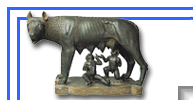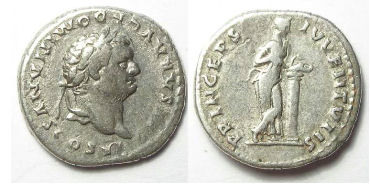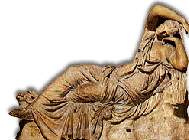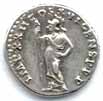 |
 |
ANCIENT ROMAN COINS - Imperial
|
|||||||||||||||||||||
|
(Reference: S=Sear Roman Coins and Their Values (2000 edtion), RSC=Roman Silver Coins, RIC=Roman Imperial Coinage, MILNE=Catalogue of Alexandrian coins; GIC=Greek Imperial Coinage by Seaby) |
|
 Domitian
as Augustus, AD 81. Silver denarius
Denomination: Silver denarius.
Mint: Rome. Date: AD 81 Size: 16.5 x 17.8 mm. Weight: 3.44 grams Reference: Sear-2748 Grade: VF Obverse: Head of Domitian right, with IMP CAES DOMITIANVS AVG P M around (the past part of the inscription is off the flan). Reverse: Garlanded and lighted altar, with TR P COS VII DES VIII P P around.
SOLD |
 Domitian as Augustus, AD 81 to 96.
Bronze quadrans with a rhinoceros. Denomination: Bronze Quadrans.
Mint: Rome. Date:
AD 83 or later.
Size:
15.3 x 16.7 mm
Weight: 3.09 grams.
Reference:
S-2834
Grade:
gXF with a dark green patination, and great
surfaces. The nicest of this type I have seen.
Obverse: Rhinocerous walking Right.
Reverse: S C with IMP DOMIT AVG GERM around. SOLD |
 Domitian
as Caesar under Vespasian,
AD 69 to 79. Silver denarius
SOLD |
 Domitian, AD 81 to 96. Silver denarius SOLD |
|
(Reference: S=Sear Roman Coins and Their Values (2000 edtion), RSC=Roman Silver Coins, RIC=Roman Imperial Coinage, MILNE=Catalogue of Alexandrian coins; GIC=Greek Imperial Coinage by Seaby) |
|
ALL PRICES ARE IN US DOLLARS
CANADIAN ORDERS MUST ADD GST/HST TO ALL PRICES
FOR ADDITIONAL ANCIENT COINS WE HAVE AVAILABLE
PLEASE SEE OUR VCOINS STORE
www.vcoins.com/calgarycoinNext page of Roman Coins
Top of Page


THE FLAVIAN DYNASTYAs the winner in the civil war, Vespasian proved to be an able ruler under whom the Roman Empire prospered. He established the short-lived Flavian dynasty, consisting of himself and his sons, Titus and Domitian. The dynasty ended when Domitian turned bad and was murdered in a plot involving his wife. For the coins of the Flavian dynasty, for each Emperor we will be listing the coin in a sequence that better reflects their historical context, rather than the more traditional alphabetical order most reference books use. This hopefully will give a better feeling of what the coins really represent. DOMITIAN, AD 81-96MINERVA SERIESIn AD 83, Domitian introduced a series of coins devoted to Minerva, his personal patron goddess, depicted in four distinctly different stances:
Each coin gives his TRP number on the obverse and generally his Imperator and Consulship numbers on the reverse, so can be easily dated to the exact year of issue. The series was struck right up to his death in 96 AD. |
| Top of Page Copyright © 1997-2005 R & T Enterprises Ltd. |
 |



